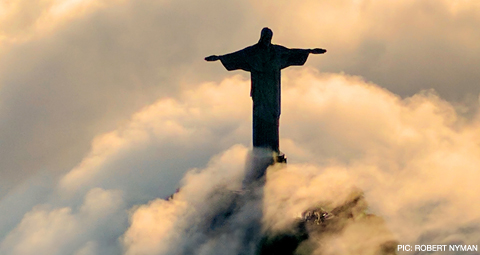March 30 | ![]() 0 COMMENTS
0 COMMENTS ![]() print
print

A people reborn in the Risen Jesus
A curious photographer has THE BOW IN THE HEAVENS defining what it means to be Catholic this Easter — By FR JOHN BOLLAN
The Lenten Station Mass with the bishop went off without a hitch. Although it pains me to say it, the bishop spoke well about the origins of these Masses and how it relates to us in our post-synodal journey of ‘Making All Things New.’ The early Christians of Rome celebrated the Eucharist in the places associated with the witness of the martyrs and this gave us an insight into the nature of the young Church as a ‘statio’ or ‘adstantes,’ standing together but also moving together in a journey of Faith.
This sense of being the local Church, the people of God in a particular place, predated the existence of parishes and their associated structures. It is this sense which we might wish to rediscover, as we pray and reflect upon the future shape of the Church in our midst.
One advantage of having the bishop make the perilous ascent above the snow line, is that you can also get him to do other little jobs for you. Our ‘Sleeping St Joseph’ statue was overdue a blessing and I was keen to have him inaugurate our new ‘cry chapel.’ Although I have been mulling over this project for some time, it had fallen into a folder in my mental filing cabinet and it was still languishing there after several months.
Thankfully my inertia was overcome by an impromptu ‘cry chapel committee,’ consisting of Sandra the housekeeper, her husband Alex, and Matthew, the sacristan.
In practical terms, this meant that an unregarded store room at the back of the church got several licks of paint, new carpet, new lighting and, most importantly of all, the addition of four items of significance.
Most prominent among these is the fibreglass ‘Tritschler Crucifix’ which hung on the sanctuary for about 40 years until I replaced it with the current icon triptych. It had always been my intention to retain it and use it elsewhere in the church, but finding the exact location was always going to be tricky.
A chapel needs an altar, and for this we are grateful to Sr Anne-Marie for the gift of a fine piece of craftmanship originally made by her father and recently adapted into an altar just narrow enough to fit into the chapel (although I may have to join in with the slimming club which meets in the church hall on a Wednesday).
The third item, again acquired thanks to the good offices of Sr Anne-Marie, is the icon of Our Lady of Perpetual Succour. This has a fascinating backstory. It once belonged to Fr John McGrain, an Edinburgh-born priest of the St Joseph’s Mission Society (Mill Hill Missionaries).
Along with the icon, Sr Anne-Marie passed on a sheaf of documents relating to Fr McGrain, including photocopies of clippings from the Scottish Catholic Observer and the Catholic Herald covering his departure for the Punjab in 1911, a presentation made to him in St Columba’s in Upper Gray Street in 1931 (or ’32) and his obituary in 1955.
Also attached was the typewritten panegyric delivered by Archbishop Gordon Gray at Fr McGrain’s funeral.
It’s immensely touching—not to mention humbling—to read through these mementoes of a well-regarded priest. It’s touching to read of the great esteem in which he was clearly held, and rightly so, given his pioneering spirit.
It’s also humbling in the sense that, for a start, I am clearly not cut from the same sturdy cloth as he and that, for all my delusions of significance, both he and I form part of ‘the thin black line’ of the priesthood.
Our memories will no doubt fade into obscurity, but the priesthood will go marching on —in some shape or other long after I’m gone.
The fourth item of interest in the cry chapel is a stone relief of the Lamb of God bearing the Latin inscription Ecce Agnus Dei qui tollit peccata mundi (‘Behold the Lamb of God who takes away the sins of the world’). I really like the style of this piece: I reckon the lettering could do with some gold-leaf to make it stand out, so that’s maybe a future project.
Its origins remain shrouded in mystery. We have a mosaic of the Lamb with the seven seals (from the Book of Revelation) as an altar frontal but, to the best of my knowledge, this did not replace an earlier work. It sat in storage in a confessional for some time and I wonder if it perhaps came from St Mungo’s, the only church in the area to be demolished.
If so, I’m delighted to think that a beautiful part of that (or some other) church lives on in St Joseph’s.
Just as the Church is the Body of Christ, so too our churches are living, organic things. It’s good that these artefacts have been transplanted from other hosts and are helping to give life to those who see them and pray through them in this place.
Although Lent is a long season, it never ceases to amaze me how Palm Sunday always seems to catch me out. Each year I make mental ‘notes to self’ as to how I can do things better, or more prayerfully, next year.
Then, without fail, I’ll walk into the sacristy and I’ll see the red vestments and the palms, and all my good intentions come flooding back. As Matthew hands me my ‘Ceremonies of Holy Week’ book, I can sense his look of reproach, as if to say, ‘It was all meant to be different this year.’
In my defence, I was on call for the hospital this week and, though it wasn’t as brutal as my previous turn on the phone, I still had a few trips up to the Inverclyde Royal Hospital.
Indeed, the hour’s sleep I lost thanks to the clocks going forward was compounded by a call at 4.45am on Palm Sunday morning. On my way out to the car, I popped into the church to collect a few palm crosses. I had already attended this lady on the Friday afternoon and I knew that she was very poorly indeed.
As I stood in her room, her children gathered with her, what unfolded was a Palm Sunday liturgy of sorts: a celebration of the triumph of the Cross, of the self-emptying love of Christ. In the end, that is what we celebrate: that our lives are bound up with the mystery of the Cross.
The week before I had tried to explain to someone who isn’t a Catholic what this means to us. A friend had asked me to agree to be interviewed by a French photographer as part of a project she is doing on the Botanic Gardens in Glasgow and the idea of paradise. Although I was wearing my best smoking jacket for the occasion, it turned out that she wasn’t interested in taking my picture.
What she wanted was an answer to various questions, all thoughtfully posed: about Genesis, the nature of the soul, about vocation, sins (especially mine), about Heaven. I tried to bring everything back to the Cross, as the tree of life.
I endeavoured to give responses which were honest, nuanced but easily understood. I think it’s more a measure of my verbosity than the interviewer’s lack of understanding, that she concluded our chat with the question, ‘So… you actually believe in God?’
“On the whole, I find it helps,” I replied.
Still, as I tried to point out to her, God loves a story-arc.
The Scriptural account of humanity begins in a garden, with a man and a woman who no longer recognise each other. The Gospel account of the renewal of humanity also unfolds with an encounter between a man and a woman in a garden, but here she comes to recognise the man through the speaking of her name: Mary sees that this is not some gardener, but her Risen Lord. Just as the Cross becomes the tree of life, so paradise is restored in a garden.
Easter is the feast of resurrection, renewal and hope. I hope that, for all of us, it brings us to meet Jesus once again as a people reborn in His rising.
Just as the early Christians ‘stationed’ themselves at the tombs of the martyrs not as mourners but as witnesses, so may we gather at the empty tomb of Jesus to marvel at His love which is stronger than death.
A blessed Easter to you all!










